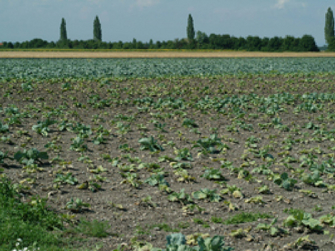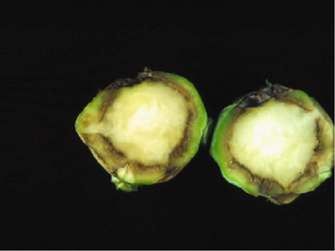Cabbage fusarium wilt
Fusarium oxysporum f. sp. conglutinans and Fusarium equiseti
Profile
Fusarium wilt on white cabbage is mostly caused by Fusarium oxysporum f. sp. conglutinans . On cabbage plants from Austrian growing areas, Fusarium equiseti has also been identified as the causal agent of the plant disease. Infestation is manifested by discoloration, leaf damage, and ultimately wilting or rotting of the plants.
Damage symptoms
Already during seedling cultivation in open fields, a stronger infestation of herbaceous plants by Fusarium oxysporum can be observed. The young plants wilt and eventually die. Stem cross-sections show yellow to dark brown discolored vascular bundle rings. Leaves wither, the just-forming head collapses, withers, rots, and a dense, whitish mesh of fungal filaments usually forms at the base of the stem. At this growth stage, differences in cultivar susceptibility can also be visually detected in field stands. Stalk cross-sections of obviously healthy plants often also show discoloration of the vascular bundle rings, even if only slight.




Host plants
The main host plants are: Corn, onion crops, celery, turnip, cabbage(Brassica species), chickpea, cucumber and other cucurbits, carrots, strawberries, soybean, sunflower, barley, tomato, millet, beans, peas, potato, and wheat.
On corn, the fungus Fusarium equiseti causes stem and cob rot.
automatically translated